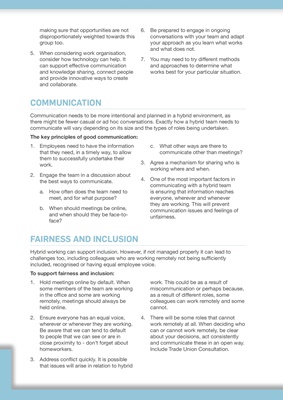
making sure that opportunities are not
disproportionately weighted towards this
group too.
5. When considering work organisation,
consider how technology can help. It
can support effective communication
and knowledge sharing, connect people
and provide innovative ways to create
and collaborate.
6. Be prepared to engage in ongoing
conversations with your team and adapt
your approach as you learn what works
and what does not.
7. You may need to try different methods
and approaches to determine what
works best for your particular situation.
COMMUNICATION
Communication needs to be more intentional and planned in a hybrid environment, as
there might be fewer casual or ad hoc conversations. Exactly how a hybrid team needs to
communicate will vary depending on its size and the types of roles being undertaken.
The key principles of good communication:
1. Employees need to have the information
that they need, in a timely way, to allow
them to successfully undertake their
work.
2. Engage the team in a discussion about
the best ways to communicate.
a. How often does the team need to
meet, and for what purpose?
b. When should meetings be online,
and when should they be face-toface?
c. What other ways are there to
communicate other than meetings?
3. Agree a mechanism for sharing who is
working where and when.
4. One of the most important factors in
communicating with a hybrid team
is ensuring that information reaches
everyone, wherever and whenever
they are working. This will prevent
communication issues and feelings of
unfairness.
FAIRNESS AND INCLUSION
Hybrid working can support inclusion. However, if not managed properly it can lead to
challenges too, including colleagues who are working remotely not being sufficiently
included, recognised or having equal employee voice.
To support fairness and inclusion:
1. Hold meetings online by default. When
some members of the team are working
in the office and some are working
remotely, meetings should always be
held online.
2. Ensure everyone has an equal voice,
wherever or whenever they are working.
Be aware that we can tend to default
to people that we can see or are in
close proximity to - don't forget about
homeworkers.
3. Address conflict quickly. It is possible
that issues will arise in relation to hybrid
work. This could be as a result of
miscommunication or perhaps because,
as a result of different roles, some
colleagues can work remotely and some
cannot.
4. There will be some roles that cannot
work remotely at all. When deciding who
can or cannot work remotely, be clear
about your decisions, act consistently
and communicate these in an open way.
Include Trade Union Consultation.